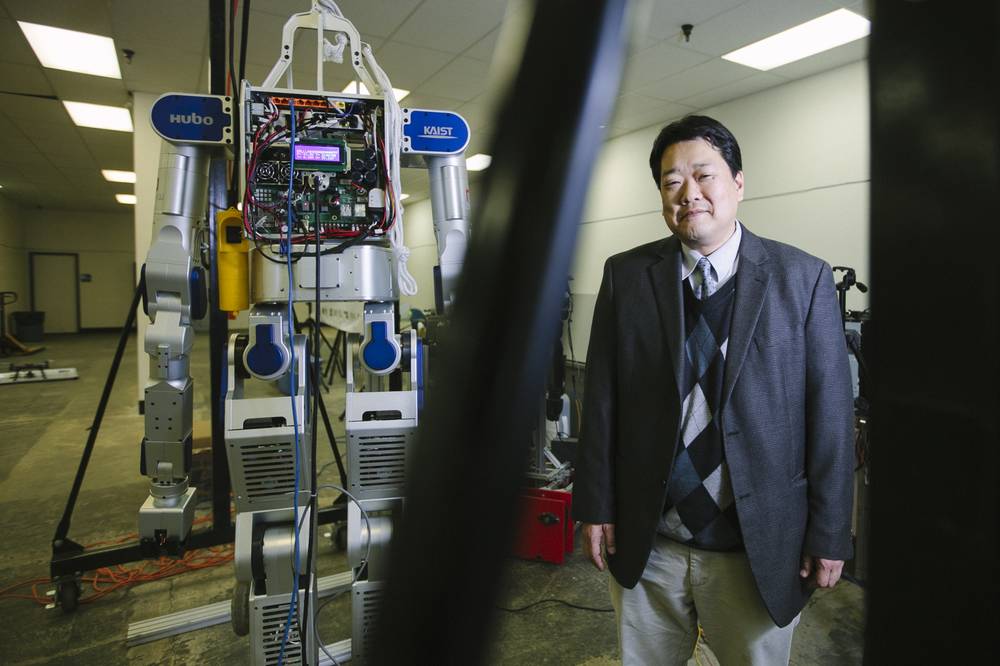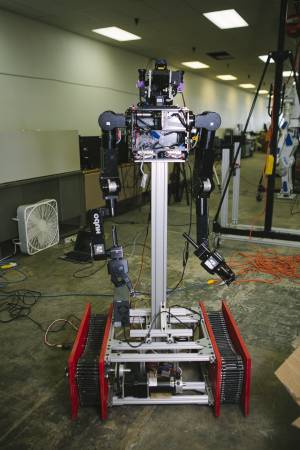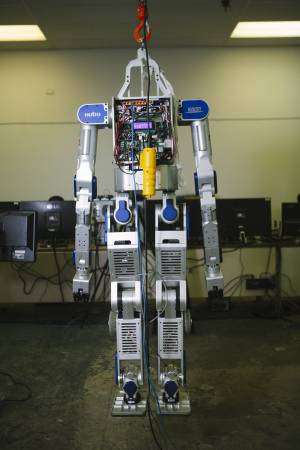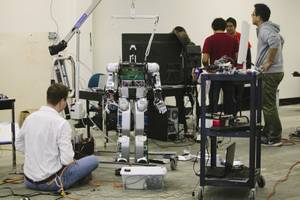"Imagine if we didn’t have skin. How dexterous would we be without it?”
We’re looking at the heavy-duty digits of a Hubo humanoid robot hanging in his UNLV engineering lab, and Paul Oh is trying to help me understand why they’re not as elegant as mine. Yet. For more than 20 years Oh has studied and advanced robotics, leaving his mark on NASA’s Jet Propulsion Lab, Boeing, the Office of Naval Research and the National Science Foundation, where he supported university research on non-military robotics. He joined UNLV’s College of Engineering in August to spearhead development of unmanned aerial systems and other “use-inspired” inventions, like robots that could help us with daily tasks as well as disasters.
In a lab that looks more like an obstacle course, he and his students are working on a humanoid that will compete for a $2 million prize in June’s DARPA Robotics Challenge, an international affair that could put Southern Nevada on the map for the kind of emerging tech that still seems like science fiction.
Robots were big at the recent Consumer Electronics Show. I was just overwhelmed that over 400 robotics companies were represented. And I believe over 40 of these drone companies were also there. ... The buzz phrase that was coming out of CES was, "Robotics are here."
What was the message to consumers? Robots are here for their quality of life, and it’s not this kind of esoteric thing that might be used in a factory or a medical operating room. They’re going to be helping us with companionship, be it elder care, be it for education … or they might be tabletop robot devices.
Who’s leading the pack in the marketplace? People often say, ‘Oh, it’s the Japanese.’ I would say that they have the market on industrial robots for, let's say, the automobile industry. But in terms of pure volume, it’s the American company iRobot, with the Roomba.
The Roomba doesn’t blow very many minds at this point, but the notion of a robot caring for a human might. That sounds so sci-fi. Ten years ago, I think you would also argue that people wouldn’t be talking to their iPhone 6. ... The acceleration of technology is not a steady thing—it’s actually ramping even faster. And that’s what is enabling these robots to have much more advanced capabilities. … Improved capabilities are driving more demand, which leads to better capabilities. Coupled with better hardware, the demand is just gonna get higher.
The DARPA challenge isn't about consumer products. It's about building a robot that could serve as a first responder, from driving a car to breaking through walls with a sledgehammer. Why is the U.S. Defense Advanced Research Projects Agency funding this? We are still cleaning up New Orleans because of Hurricane Katrina. It is projected that Fukushima cleanup will take until the year 2030. As heroic a first responder as you are, I don’t think you want to spend the next 10 years doing cleanup, but it has to be done, and it is also toxic.
Is the idea to gradually phase out human forces for robot ones that can withstand radiation and other hazards? I don’t think when people actually see this that they're going to say, 'Wow, [robots] are taking over.' No. I think the heroes are our firefighters, the first responders; that’s never going to change. But there are times we want to augment and keep them out of harm’s way. … To them, they’re not doing it to be a hero, and the deterrent of “harm’s way” is not in their vocabulary. A baby needs to be saved; a person needs to be pulled out of a fire. But I think there’s even lower-hanging fruit that needs to be done. For example, I’m much more interested in disaster cleanup than I am with the 72-hour golden window of disaster mitigation.
You see robots doing other high-volume jobs that have to be done, from monitoring food safety to salvaging heavy recyclables. Given the money that could be saved—and made—in the U.S., is our government investing in robotics? President Obama, I believe it was around summer of 2012, launched the National Robotics Initiative along the theme of collaborative robotics, so that was definitely a milestone. … At the same time, both Asia and Europe have been doing this for over a decade, maybe two decades, usually at one to two orders of magnitude more money. For others, it’s their Apollo space program. Their taxpayers are saying, yes, pour in more money; we want to be more competitive; we want to be the leaders in unmanned air systems; we want to be the leaders in consumer robotics. Again, you want a mixture of public and private investment to this.
Either way, can America catch up? I think it depends how hungry America is, how passionate. We’ve always prided ourselves on being a can-do nation, but let’s face it; people are saying that we are falling behind because of global competition. Not just because of what they can produce, but our students aren’t ready for tomorrow’s engineering jobs, and that’s not something you simply outsource.
Getting kids into science is key, and I think sci-fi can be a good entry point. For some of my robotics colleagues, it was Star Wars. Two things that inspired me: The Six Million Dollar Man and Blade Runner. They’re different in the sense that it was an existentialist question. Six Million Dollar Man is like, "People see me as a freak. When my skin is burned and they see the circuit board, people scream and run away." Same thing with Blade Runner, that scene was like, "Why do I exist?" And they have this built-in termination time, an expiration date. I even say that Frankenstein is a robot, in some sense. I think Pinocchio is, the Tin Man. These are all robots that question existentialist identity—what does it mean to be human?
Sentience, personality, creativity. These are things humans have dreamed of seeing in a robot, but they also fear what could happen if we lose control. There will be signs and wonders telling us we’ve reached this stage of robotic evolution. We’re not there yet. The near-term that I’m seeing, by 2020, is being able to augment human shortages, be it for these high-volume tasks. But yes indeed, there will come a point where you could have robots that could be starting to be creative. There is definitely work in artificial intelligence where we’ve tried to understand what creativity means. Music is a form of creative expression, but could you actually have robots playing musical instruments almost in improvised jazz style, where it’s not scripted, it’s not sheets of music, but based on what other players are doing? Dance is another form of creative expression. Can robots do a dance performance, unchoreographed, that could fool human judges? … There are researchers looking toward that.
What about the ethics of drone technology? Is there much discussion in your circle about it? Absolutely. I just came back from San Francisco, where we had our Robotics and Automation Society long-range planning meeting, and we have formed a robotics ethics technical committee. We're also wanting to have more of a voice to our individual government decision-makers—be it Japan, Korea, China, Europe, the United States—on the ethical issues of robotics, especially drones, given the lethality we’ve seen as well as the privacy concerns.
Given Nevada's regional designation as an FAA site for drone testing, training and research, I'm sure the state is interested in your work. In the first month that I was at UNLV, I met with a lot of the unmanned air systems stakeholders, be it from K-12, be it from the industry, be it from the Governor’s Office of Economic Development. There was no lack of enthusiasm for unmanned air systems or drones. But what I found perplexing was that they didn’t have something to sink their teeth into. It wasn’t like there was this huge federal grant that all of Nevada’s UAS drone stakeholders are working on. Yes, we have the FAA test site, but if I asked you, okay, give me a tour of the test site, where do we begin? There’s nothing really centralized. … So, almost like a revelation, I thought, maybe we could use the DARPA Robotics Challenge to get the UAS stakeholders to rally, to participate, to really be able to show the rest of Nevada and the country that high-tech lives here in Las Vegas. I think once people actually see this Hubo hardware, there’s no mistake that this is world-class, and it's in your backyard.
I'm definitely digging your DARPA humanoid's knee-wheels! I do not believe a robot has to look and function the way people do. I would personally love to have an extra pair of hands and arms. Sometimes I wish I had a tail (laughs). … I think people are attracted to robotics because there’s an element of fantasy, regardless of age and culture, that has yet to be realized. Like flying used to be this fantasy. We’ve realized it. Going to the moon. Going underwater in the deep. But people have yet to get the robot of their dreams, whether it’s to be somebody that does your chores or is kind of like the buddy, the brother that you never had that will play baseball with you. I think that’s why robots still have this kind of allure. And part of it has to be the aesthetics. If it looks too human, people get kind of freaked out. I like the example of R2-D2 and C-3PO. Most people are more enamored with R2-D2.
He’s less creepy. Exactly. You couldn’t even understand what it was saying because it just kind of beeped, but it made these cute sounds, and people were attracted. C-3PO had this kind of uptight demeanor that, although it looked more human, it didn't have the same interaction with people.
Your lab's Hubos seem to have the right balance. There are only a handful in the U.S., at schools like MIT and Virginia Tech. Yet your students are wrenching on them. I think there’s a lot of value in hands-on getting over their fear of working with something they’ve never used before, being able to take the arm off and put the arm back. When I was in engineering school we had to build our own computer, so we didn’t have any problems opening it up and sticking in a sound card or a new graphics card. But today, people buy a computer from the store and they never open it up.
There is a tech-intimidation factor, which might explain our pop-cultural obsession with personifying robots. Speaking of, I've heard your DARPA Hubo will be named through a public vote. What about Elvis? (laughs) I don’t know. Maybe if I could come up with a nice acronym that goes with ELVIS.
You went through the first phase of the competition with a team at your former employer, Drexel University, and even though you didn't make the cut for the final, DARPA invited you back. Why? We weren’t like a Lockheed Martin with a war chest and legions of engineers to work on it. We were students that just put all their heart into this. They stayed up sometimes 48 hours, two, three days in a row just to get this to work. And it’s a part of their life that they’ll never forget, and I think it’s going to really shape and form them. I love that when I first landed in Vegas to start my job, there was a huge UNLV banner at the airport, and it said, “Training Tomorrow’s Leaders.” I took a picture of that and I said, "Yeah, this is the reminder. This is why I’m here."










